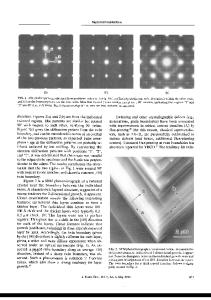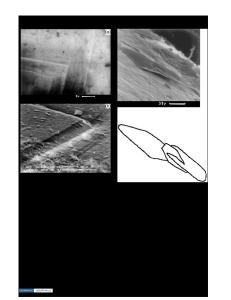110K Superconducting Fibers of [Bi,Pb(Sb)] 2 Sr 2 Ca 2 Cu 2 O 10 + x
- PDF / 1,132,641 Bytes
- 4 Pages / 420.48 x 639 pts Page_size
- 22 Downloads / 371 Views
110K SUPERCONDUCTING FIBERS OF [Bi,Pb(Sb)j]SrCaCusOio. Zhang Jincang*,He Aisheng**,Huo Yujing*** and He Yusheng*** *Henan Normal University,XinXiang 453002,China **North University of Technology,Beijing 100041,China ***Tsinghua University,Beijing 100084,China ABSTRACT Superconducting fibers of [Bi,Pb(Sb)],SrCa2CusOl.+x high To superconducting materials have been prepared by means of the laser-heated pedestal growth method with Tco=110K and JC>103 A/cm 2 . Structure analysis showed that the a-b plane of the material prefers to align along the growth direction,though the post-growth heat treatment,which is still necessary at present stage,may destroy the texture structure in some extent.The existence of Pb is vital for stabilizing the 110K phase of the Bi-based fibers. INTRODUCTION Since the discovery of high temperature superconducting transitions in the copper oxide perovskite systems by Bednorz and Muller [1],great efforts have been made to fabricate high quality superconducting wires or single crystal fibers for measurements of properties and potential applications.The laserheated pedestal growth (LHPG) method has drawn much attention since it is a powerful method for rapidly growing single crystal fibers of micrometer diameter. Initial attempts with the (La,Sr)2CuO 4 and YBaCu307 systems were made [21 by R.S.Feigelson et al in 1987,and the first successful high Tc (Tco=85K) fiber was obtained in the Bi2SrzCaCuzOe+s system by the same group [3] in 1988. In this paper, we will present our (2:2:2:3) phase Bi-based fibers with the highest zero resistance temperature (Tco=110K) so far reported.The superconducting properties,structure and growth conditions of these fibers will also be discussed. FIBER PREPARATION The nominal composition of the source material in these experiments was Bii.83(Pb 1 -,Sby)a. 3Sri.gCa,.o 3 Cu3.o Oo+ (y=0-0.3). The material was prepared from Bi 2 OS, CaCO 3 , SrCOs and CuO powders with analytic purity. The appropriate amounts were mixed together, ground, pressed into pellets and calcined in air at 8000C for 24 hours. After being ground and pressed again, the pellets were sintered in air at 840-8600C for more than 60 hours and then furnace cooled. The polycrystalline pellets were cut into rectangular rods of 0.5x0.5x20 mm3 , which were used both as the source material and for seeds. To fabricate micrometer fibers, the LHPG method was used, which is basically a technique. The top of the source rod is melted by a tightly focused laser beam. The seed, after being introduced into the melt, is pulled upwards at a proper rate and the growth is then accomplished. Computer control is necessary
Mat. Res. Soc. Symp. Proc. Vol. 169. •1990 Materials Research Society
318
to adjust the pulling rate of seed and the feeding rate of the source rod so as to maintain constant melt volume and achieve desired fiber diameter. Details of the technique is similar to that as described in Ref. [3]. The practical growth rates of this work were about 0.04-1.0 mm/min, the diameters of fibers were about 30-300 um and
Data Loading...











